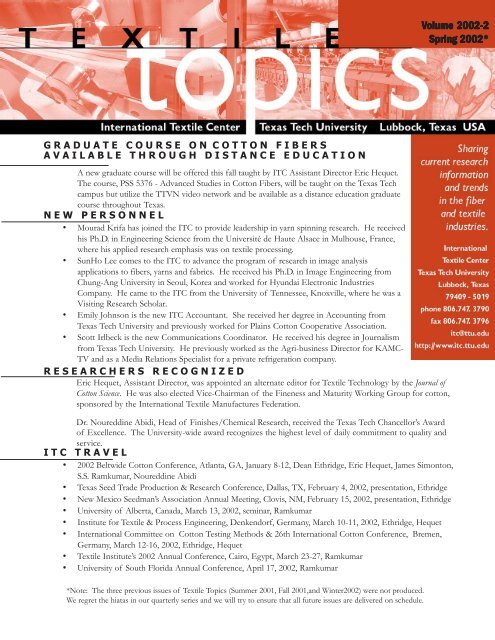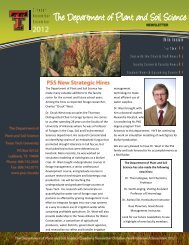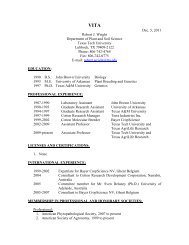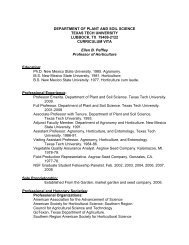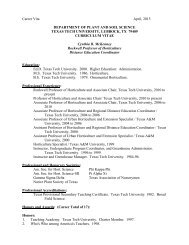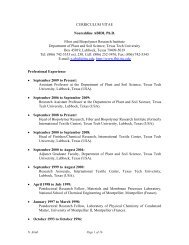Volume 2002-2 olume 2002-2 Spring 2002* - Texas Tech University
Volume 2002-2 olume 2002-2 Spring 2002* - Texas Tech University
Volume 2002-2 olume 2002-2 Spring 2002* - Texas Tech University
You also want an ePaper? Increase the reach of your titles
YUMPU automatically turns print PDFs into web optimized ePapers that Google loves.
<strong>V<strong>olume</strong></strong> <strong>2002</strong>-2<br />
<strong>Spring</strong> <strong>2002</strong>*<br />
G R A D U A T E C O U R S E O N C O T T O N F I B E R S<br />
A V A I L A B L E T H R O U G H D I S T A N C E E D U C A T I O N<br />
A new graduate course will be offered this fall taught by ITC Assistant Director Eric Hequet.<br />
The course, PSS 5376 - Advanced Studies in Cotton Fibers, will be taught on the <strong>Texas</strong> <strong>Tech</strong><br />
campus but utilize the TTVN video network and be available as a distance education graduate<br />
course throughout <strong>Texas</strong>.<br />
N E W P E R S O N N E L<br />
• Mourad Krifa has joined the ITC to provide leadership in yarn spinning research. He received<br />
his Ph.D. in Engineering Science from the Université de Haute Alsace in Mulhouse, France,<br />
where his applied research emphasis was on textile processing.<br />
• SunHo Lee comes to the ITC to advance the program of research in image analysis<br />
applications to fibers, yarns and fabrics. He received his Ph.D. in Image Engineering from<br />
Chung-Ang <strong>University</strong> in Seoul, Korea and worked for Hyundai Electronic Industries<br />
Company. He came to the ITC from the <strong>University</strong> of Tennessee, Knoxville, where he was a<br />
Visiting Research Scholar.<br />
• Emily Johnson is the new ITC Accountant. She received her degree in Accounting from<br />
<strong>Texas</strong> <strong>Tech</strong> <strong>University</strong> and previously worked for Plains Cotton Cooperative Association.<br />
• Scott Irlbeck is the new Communications Coordinator. He received his degree in Journalism<br />
from <strong>Texas</strong> <strong>Tech</strong> <strong>University</strong>. He previously worked as the Agri-business Director for KAMC-<br />
TV and as a Media Relations Specialist for a private refrigeration company.<br />
R E S E A R C H E R S R E C O G N I Z E D<br />
Eric Hequet, Assistant Director, was appointed an alternate editor for Textile <strong>Tech</strong>nology by the Journal of<br />
Cotton Science. He was also elected Vice-Chairman of the Fineness and Maturity Working Group for cotton,<br />
sponsored by the International Textile Manufactures Federation.<br />
Dr. Noureddine Abidi, Head of Finishes/Chemical Research, received the <strong>Texas</strong> <strong>Tech</strong> Chancellor’s Award<br />
of Excellence. The <strong>University</strong>-wide award recognizes the highest level of daily commitment to quality and<br />
service.<br />
I T C T R A V E L<br />
• <strong>2002</strong> Beltwide Cotton Conference, Atlanta, GA, January 8-12, Dean Ethridge, Eric Hequet, James Simonton,<br />
S.S. Ramkumar, Noureddine Abidi<br />
• <strong>Texas</strong> Seed Trade Production & Research Conference, Dallas, TX, February 4, <strong>2002</strong>, presentation, Ethridge<br />
• New Mexico Seedman’s Association Annual Meeting, Clovis, NM, February 15, <strong>2002</strong>, presentation, Ethridge<br />
• <strong>University</strong> of Alberta, Canada, March 13, <strong>2002</strong>, seminar, Ramkumar<br />
• Institute for Textile & Process Engineering, Denkendorf, Germany, March 10-11, <strong>2002</strong>, Ethridge, Hequet<br />
• International Committee on Cotton Testing Methods & 26th International Cotton Conference, Bremen,<br />
Germany, March 12-16, <strong>2002</strong>, Ethridge, Hequet<br />
• Textile Institute’s <strong>2002</strong> Annual Conference, Cairo, Egypt, March 23-27, Ramkumar<br />
• <strong>University</strong> of South Florida Annual Conference, April 17, <strong>2002</strong>, Ramkumar<br />
*Note: The three previous issues of Textile Topics (Summer 2001, Fall 2001,and Winter<strong>2002</strong>) were not produced.<br />
We regret the hiatas in our quarterly series and we will try to ensure that all future issues are delivered on schedule.
COMPACT SPINNING: NEW POTENTIAL FOR SHORT STAPLE COTTONS<br />
Mourad Krifa<br />
Eric Hequet<br />
Dean Ethridge<br />
The <strong>Texas</strong> Food and Fiber Commission funded the research reported<br />
here.<br />
2<br />
I N T R O D U C T I O N<br />
During the last two decades, components of ring<br />
spinning machines have been greatly improved.<br />
Changes in drafting systems, drive systems, and<br />
robotics have enabled large gains in productivity,<br />
flexibility, and quality (Stahlecker, 1995; Seuberling,<br />
1995; Hequet, et. al, 1998).<br />
Most of the technical advances in ring spinning were<br />
aimed at improving the performance of the existing<br />
technology. In recent years, however, a bona fide<br />
innovation has occurred. It is called “compact” or<br />
“condensed” spinning, because it minimizes width and<br />
height of the spinning triangle associated with ring<br />
spinning (see Figure 1).<br />
Several experts have described the technical principles<br />
of compact spinning that result in a more organized<br />
structure without peripheral fibers and with a better<br />
twist distribution (Artzt, 2000; Meyer, 2000; Olbrich,<br />
2000; Stalder, 2000). As a result of this enhanced<br />
structure, the compact yarn shows higher strength,<br />
reduced hairiness, and improved evenness (see Figure<br />
1).<br />
The first compact spinning system to be<br />
commercialized is by the Rieter Corporation and is<br />
called Com4 ® spinning. This system was designed and<br />
is marketed only for use with extra-long-staple cottons<br />
to make only the very fine yarn sizes (i.e., 50 Ne and<br />
finer). However, compact spinning systems are also<br />
made by Suessen (the EliTe ® ) and by Zinser (the Air-<br />
Com-Tex 700 ® ), both which are designed to<br />
accommodate the full spectrum of staple lengths spun<br />
today. These compact spinning systems offer the<br />
possibility of using cottons with shorter staple lengths<br />
to produce high-quality yarns that heretofore required<br />
long- or extra-long-staple cottons.<br />
This paper reports results obtained from spinning<br />
various <strong>Texas</strong> upland cottons, along with some other<br />
representative U.S. upland cottons, on both<br />
conventional and compact spinning systems. The<br />
spinning machines used were the Suessen Fiomax 1000<br />
(for conventional ring spinning) and the Suessen EliTe<br />
1000 (the Fiomax 1000 fitted with the compacting<br />
system). The focus is twofold: (1) evaluate the<br />
performance of these cottons on modern conventional<br />
s p r i n g 2 0 0 2<br />
ring spinning machines, and (2) evaluate the<br />
improvements in performance resulting from compact<br />
spinning.<br />
P R O C E D U R E<br />
Thirty-one bales of <strong>Texas</strong> upland cotton were selected<br />
in a manner to ensure nine groupings of fibers with<br />
different values for fiber length and micronaire.<br />
Sampling strata and the resulting number of bales in<br />
each stratum are as follows:<br />
The main cause of differing numbers of bales in each<br />
stratum (or cell) was the initial bale selection process<br />
being based on USDA classing data, but more exacting<br />
measurements taken at the International Textile Center<br />
shifted some of the bales to different categories. (Each<br />
bale was sampled at 10 layers throughout, with HVI<br />
measurements being done on each layer. Each<br />
measurement consisted of 4 replications of micronaire<br />
and 10 replications of length and strength.)<br />
In addition to the <strong>Texas</strong> bales, 6 representative, highquality<br />
bales were selected from other regions of the<br />
U.S. cotton belt: 3 bales from the Delta and 3 from<br />
California. Thus, all 6 of these bales fell into the<br />
“long” length category and care was taken not to get<br />
micronaire values higher than 4.90 from the Delta. The<br />
California cottons were all high-quality Acala varieties.<br />
The purpose of these 6 cottons, all of which are<br />
deemed appropriate for use on ring spinning systems,<br />
was to provide a better frame of reference for<br />
evaluating the performance of the <strong>Texas</strong> cottons.<br />
A statistical summary of the HVI fiber data for all 37<br />
bales used in the study is given in Table 1.<br />
Preliminary experiments were done to evaluate the<br />
spin-ability limits of a representative <strong>Texas</strong> bale from<br />
each sampling strata. These experiments enabled an<br />
efficient selection of yarn sizes to make in the larger<br />
experimental design. Results from this made it clear<br />
that the compact spinning technology would open the
ing spinning to cottons that are not generally<br />
considered suitable for this process. Indeed, all of the<br />
test cottons could be taken far beyond typical spinability<br />
limits on a conventional ring spinning system.<br />
The experimental procedure used on all 37 cotton bales<br />
is shown in Figure 2. The yarn sizes for each length<br />
group were chosen to enable useful comparisons<br />
between the conventional and compact yarns.<br />
The yarn produced at the close of these trials was<br />
tested for the following properties:<br />
• Evenness on UT3 (10 bobbins; 400 m/bobbin)<br />
• Single end break (10 bobbins; 10 breaks/bobbin)<br />
• Skein break (10 bobbins; 1 skein/bobbin)<br />
• Hairiness on Zweigle hairiness tester (10 bobbins;<br />
100 meters/bobbin)<br />
R E S U L T S A N D D I S C U S S I O N<br />
Evenness Parameters<br />
Analysis of variance on the yarn evenness data is<br />
summarized in Table 2. It accounts for the part of<br />
output variance from the yarn count within each length<br />
group (Length Group x Count), then tests for the<br />
effects of categorical factors (Spinning System, Length<br />
Group, and Length Group x Spinning System). Results<br />
indicate that, after controlling for the yarn count within<br />
length groups, there is no significant effect of compact<br />
spinning on yarn evenness parameters of the UT3.<br />
The 26 Ne yarn size was the only one spun for every<br />
cotton bale (Figure 2). Therefore, it is used to illustrate<br />
the yarn evenness parameters resulting from the<br />
spinning trials (Figure 3). The results are similar for the<br />
other yarn sizes.<br />
The 25% and 50% quality levels of the USTER<br />
Statistics are shown by the horizontal lines on the<br />
graphs in Figure 3, in order to provide benchmarks for<br />
the results shown. To facilitate reading the results, the<br />
31 <strong>Texas</strong> cottons are listed first on the horizontal axis,<br />
followed by the 3 Delta cottons and then the 3<br />
California cottons.<br />
Conclusions from Figure 3 include the following:<br />
- The compact spinning did not make much<br />
difference in the yarn evenness data from the<br />
UT3.<br />
- Most of the <strong>Texas</strong> cottons compared well with<br />
the Uster Statistics; they fared worst for the thin<br />
places and best for the neps.<br />
- Most of the <strong>Texas</strong> cottons performed better than<br />
the Delta cottons and some of the <strong>Texas</strong> cottons<br />
compared favorably with the California cottons.<br />
TEXTILE TOPICS<br />
A research bulletin on fiber<br />
and textile industries.<br />
<strong>Spring</strong> <strong>2002</strong> - Vol <strong>2002</strong>-2<br />
Published quarterly<br />
<strong>Texas</strong> <strong>Tech</strong> <strong>University</strong><br />
International Textile Center<br />
P.O. Box 45019<br />
Lubbock, TX 79409-5019<br />
Yarn Hairiness<br />
The scatter plot showing UT3 hairiness indexes (H) for<br />
conventional versus compact yarns is given in Figure 4.<br />
The hairiness index values are highly correlated, but the<br />
values are significantly lower for the compact yarns (as<br />
shown by comparison with the equality line in Figure<br />
4). In fact, the hairiness levels for the compact yarns<br />
are generally low enough to rank well into the best<br />
quartile of the Uster Statistics.<br />
The scatter plot showing the Zweigle hairiness indexes<br />
(S3) for conventional versus compact yarns is given in<br />
Figure 5. Unlike the results with the UT3, the<br />
correlation between values for compact versus noncompact<br />
spinning is very low. The hairiness levels of<br />
the compact yarns are generally very low regardless of<br />
the levels exhibited by the conventional yarns.<br />
However, a few of the yarns in all length groups had S3<br />
values that were quite high.<br />
The foregoing observations are corroborated by the<br />
analysis of variance results in Table 3. The effect of<br />
compact spinning is highly significant, as is the<br />
interaction between length groups and compact<br />
spinning (Group x Spinning System).<br />
The interaction effect (Group x Spinning System) may<br />
be visualized by charting the average H or S3 values for<br />
each length group on each of the spinning systems.<br />
This is done for the H values in Figure 6, using the 26<br />
Ne yarn as a reference point. This shows that yarn<br />
hairiness improvement is greater for the shortest fibers<br />
(Length Group 1). The experimental design explicitly<br />
targeted the distinct length groups. However, there are<br />
other significant interaction terms that could have been<br />
explored (e.g., Strength Group x Spinning System,<br />
Short Fiber Content Group x Spinning System,<br />
Fineness Group x Spinning System, etc.). It is expected<br />
and that inclusion of these could alter the residual<br />
effect detected for the Length Group interaction term.<br />
Yarn Tensile Properties<br />
The relationships between conventional and compact<br />
yarn tensile properties are represented in Figures 7 and<br />
8, for elongation and single-end strength respectively.<br />
The analysis of variance results for these two tensile<br />
properties are summarized in Table 4.<br />
These results show that compact spinning resulted in a<br />
highly significant improvement in both elongation and<br />
strength of yarns. While the slight deviations of the<br />
regression line slopes suggest a possible interaction<br />
between compact spinning and these tensile properties<br />
(Figures 7 & 8), the analysis of variance (Table 4)<br />
shows that the “Length Group x Spinning System”<br />
3
interaction term is not statistically significant at a 5%<br />
confidence level.<br />
The average yarn strength values for each length group<br />
and for both conventional and compact spinning<br />
systems are illustrated in Figure 9. Again, 26 Ne yarn is<br />
used as reference point. While the gap between<br />
conventional and compact yarns is somewhat wider for<br />
the shortest fibers (Length Group 1), this difference<br />
was not statistically significant. As with the hairiness, it<br />
is quite likely that interactions with other variables<br />
affecting the yarn strength are occurring besides length<br />
groups. An alternative experimental design that allowed<br />
inclusion of these other variables might reveal a<br />
stronger residual effect for length groups.<br />
A charting of the yarn strengths and elongations from<br />
each cotton bale with conventional versus compact<br />
spinning is given in Figure 10. It clearly shows that the<br />
compact spinning resulted in a generally higher strength<br />
and greater elongation for the 37 bales of cotton.<br />
It should be noted that the <strong>Texas</strong> cottons were<br />
specifically selected to include a wide spectrum of the<br />
cottons produced in this very large state, while the<br />
Delta and California cottons were selected to be<br />
representative of the average length of the upland<br />
cottons from these areas. The range of micronaire was<br />
selected in the same manner for all three locations.<br />
Clearly many of the <strong>Texas</strong> cottons perform equal to or<br />
better than the selected Delta cottons and some of the<br />
<strong>Texas</strong> cottons are comparable to the selected California<br />
Acala varieties.<br />
C O N C L U S I O N<br />
The yarn structure resulting from compact spinning<br />
technology appears to get very close to a maximum<br />
utilization of each fiber in the yarn bundle. This makes<br />
it possible to achieve higher yarn strength from any<br />
fibers used. However, the improvements in yarn<br />
strength appear to be greater for shorter stapled<br />
cottons than for the longer staple lengths. These<br />
results made it clear that some fibers that were<br />
inadequate for use in conventional ring spinning may<br />
be spun satisfactorily on the compact system.<br />
As expected, compact spinning greatly reduced the<br />
hairiness of yarns. As with the tensile properties, the<br />
greatest reductions in hairiness occurred with the<br />
shorter stapled fibers.<br />
Compact spinning did not result in significant<br />
improvements in any of the yarn evenness parameters<br />
tested with the UT3. Furthermore, this conclusion<br />
held for all staple length categories.<br />
Taken together, these results suggest that compact<br />
spinning technology may enable us to extend the use of<br />
shorter stapled cottons into the manufacture of finer<br />
yarns than has heretofore been feasible. It exemplifies a<br />
technological innovation that, instead of making<br />
greater demands on fiber properties, actually<br />
compensates for the lack of certain fiber properties.<br />
Finally, these results reveal that some of <strong>Texas</strong>’ cottons<br />
are among the best upland cotton fibers produced in<br />
the U.S. Thus, on average the <strong>Texas</strong> cottons performed<br />
as well as or better than the high-quality Delta cottons<br />
on both the conventional and compact ring spinning<br />
systems. And a subset of the <strong>Texas</strong> cottons performed<br />
as well as or better than the high-quality California<br />
cottons.<br />
R E F E R E N C E S<br />
Artzt P., 2000. The special structure of compact yarns -<br />
Advantages in downstream processing. Beltwide Cotton<br />
Conferences, January 4-8, San Antonio, TX (USA),<br />
National Cotton Council of America. Memphis, TN<br />
(USA), pp. 798-803.<br />
Hequet E., Ethridge D., and Cole W. D., 1998. Evaluation<br />
of improvement in yarn quality with new ring spinning<br />
frame. Textile Topics (4: fall 1998): 2-8.<br />
Meyer U., 2000. Compact yarns: innovation as a sector<br />
driving force. Melliand International, 6 (1): 2.<br />
Olbrich A., 2000. The AIR-COM-TEX 700 condenser<br />
ring spinning machine. Melliand International, 6 (1): 25-<br />
29.<br />
Seuberling J., 1995. Advanced standard in ring spinning.<br />
Melliand International (1): 25-26.<br />
Stahlecker H., 1995. Fiomax: High speed spinning<br />
machine. Melliand International (1): 27-28.<br />
Stalder H., 2000. New spinning process ComforSpin.<br />
Melliand International, 6 (1): 22-25.<br />
4 s p r i n g 2 0 0 2
Ring Yarn<br />
Compact Yarn<br />
Source: P. Artzt, D. Betz, W. Joas,<br />
Inst. of Textile <strong>Tech</strong>nology and Process Engineering<br />
Denkendorf, Germany<br />
Source: Zinser|Saurer Group<br />
Figure 1: Spinning Triangle and Yarn Structure; Conventional Ring Spun Yarn Versus Compact Yarn<br />
Figure 3: 26 Ne Conventional and Compact Yarn Evenness Perameters<br />
6 s p r i n g 2 0 0 2
Figure 2: Spinning Procedure<br />
Figure 4: Hairiness (UT3), Conventional vs.<br />
Compact Yarns (26 Ne)<br />
Figure 5: Hairiness (S3), Conventional vs.<br />
Compact Yarns (26 Ne)<br />
Figure 6: Average Hairiness (UT3) by Length Groups,<br />
Conventional vs. Compact Yarns<br />
Figure 7: Elongation (%), Conventional vs. Compact<br />
Yarns (26 Ne)<br />
7
Figure 8: Single-end Break Strength (cN/tex),<br />
Conventional vs. Compact Yarns (26 Ne)<br />
Figure 9: Average Yarn Strength (cN/tex) by Length<br />
Groups, Conventional vs. Compact Yarns<br />
Figure 10: 26 Ne Conventional vs. Compact Yarn Tensile Properties<br />
8 s p r i n g 2 0 0 2


